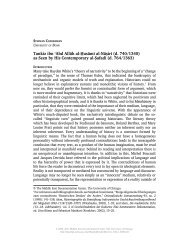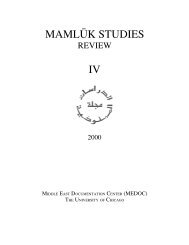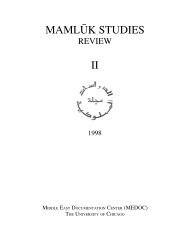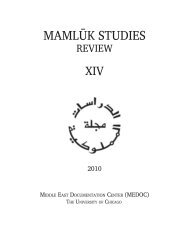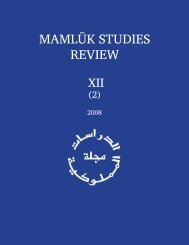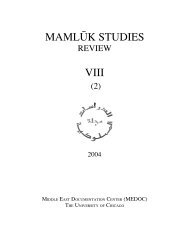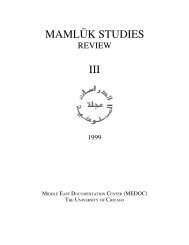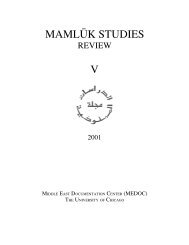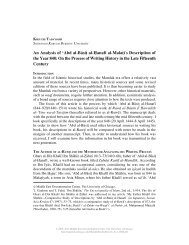Mamluk Studies Review Vol. VI (2002)
Mamluk Studies Review Vol. VI (2002)
Mamluk Studies Review Vol. VI (2002)
You also want an ePaper? Increase the reach of your titles
YUMPU automatically turns print PDFs into web optimized ePapers that Google loves.
24 STEPHAN CONERMANN AND SUAD SAGHBINI, AWLA≠D AL-NA≠S AS FOUNDERS<br />
progeny of the <strong>Mamluk</strong> serving class, as distinct from the protégés of the ruler<br />
and his <strong>Mamluk</strong>s, are of sociohistorical importance in their own right. We know<br />
from the contemporary chronicles and additional prosopographic sources that these<br />
<strong>Mamluk</strong> offspring not only participated in numerous social functions, but also<br />
developed a distinct collective identity. For example, they were called by a collective<br />
name: awla≠d al-na≠s. This term not only signified the second generation of <strong>Mamluk</strong><br />
sons but also the grand- and even the great-grandsons. The name points to common<br />
roots as a specific feature. They were united in their being "sons of the nobles,"<br />
i.e., the Turko-Circassian elite. The awla≠d al-na≠s represented the opportunities<br />
and limits of development in <strong>Mamluk</strong> society. They were connected to the realm<br />
of the state, the army, and the economy dominated by the <strong>Mamluk</strong>s through their<br />
fathers without really belonging to them. Characteristically, they usually had Arab<br />
names. 9 Their place of birth made the awla≠d al-na≠s Egyptians without the local<br />
populace accepting these second generation (and thus second class) "Turks" as<br />
their own. Many <strong>Mamluk</strong> sons, who often had an Egyptian mother and spoke<br />
Arabic as well as Turkish, assumed the role of mediators between the two worlds.<br />
Yet, psychologically and socially their situation was not enviable. Their ambitions<br />
were strictly circumscribed from the outset. On the one hand, religious scholars<br />
and other segments of the population resented them as a visible manifestation of<br />
"Turkish" domination. On the other hand, they were refused access to the highest<br />
offices of the state by the <strong>Mamluk</strong>s. But even in this the <strong>Mamluk</strong>s were inconsistent,<br />
because the highest offices of state were held by the sons of amirs in the middle of<br />
the eighth/fourteenth century under Sultan H˝asan (r. 748–52/1347–51). 10 Even<br />
during the subsequent systematic "re-<strong>Mamluk</strong>ization" of the army and state<br />
leadership there were still two awla≠d al-na≠s amongst the nine imprisoned amirs of<br />
highest rank when Sultan Barqu≠q (r. 784–91/1382–89) was overthrown in<br />
791/1388–89. 11 At this time their share in the middle and lower ranks rose to a<br />
quarter and more than a half respectively. 12 Certain high offices, such as the<br />
commandant of Cairo or the administrator of the ruler's tournament grounds, were<br />
text for publication. On its author, see Ulrich Haarmann, "The Writer as an Individual in Medieval<br />
Muslim Society," in Individual and Society in the Mediterranean Muslim World: Issues and<br />
Sources, ed. Randi Deguilhem (Aix-en-Provence, 1998), 77–87, and idem, "Al-Maqr|z|, the Master,<br />
and Abu≠ H˝a≠mid al-Quds|, the Disciple—Whose Historical Writing Can Claim More Topicality<br />
and Modernity?," in The Historiography of Islamic Egypt (c. 950–1800), The Medieval<br />
Mediterranean, vol. 31, ed. Hugh Kennedy (Leiden, 2001), 149–65.<br />
9<br />
Ayalon, "Names, Titles and 'Nisbas'," 229–31. For those awla≠d al-na≠s who had Turkish names,<br />
see Haarmann, "Arabic in Speech," 103, n. 109.<br />
10<br />
Haarmann, ""Sons of <strong>Mamluk</strong>s," 145.<br />
11 Haarmann, "Der arabische Osten," 227.<br />
12 Haarmann, "Sons of <strong>Mamluk</strong>s," 145, n. 5.<br />
© <strong>2002</strong>, 2012 Middle East Documentation Center, The University of Chicago.<br />
http://mamluk.uchicago.edu/<strong>Mamluk</strong><strong>Studies</strong><strong>Review</strong>_<strong>VI</strong>_<strong>2002</strong>.pdf



